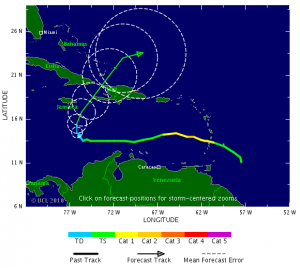
Ida originated as a tropical storm in the Caribbean but later made landfall at the end of August, where it lashed the mainland in Louisiana with Category 4 wind speeds.
Tomas hurricane track full#
In 2021 the season erupted in full force in August with Hurricane Ida. Which Months are the Most Likely Months a Hurricane will hit St. Thomas, is a Caribbean paradise! However, its location in the Eastern Caribbean also makes it particularly vulnerable to tropical storms and hurricanes. John, along with its sister U.S Virgin Islands (USVI), St Croix and St.

To help put your anxiety to rest, we offer up some tips for navigating travel to St John during hurricane season. However, hurricane season may actually be one of the best times to visit St John Virgin Islands. With the recent devastation of Hurricane Harvey, Irma and Maria, travelers are understandably worried about their safety. Hurricane season sounds sort of ominous when you have only seen catastrophic devastation on TV. The USVI is at risk for hurricanes or tropical storms from June 1 to November 30, with the peak period starting in mid-August and ending before October 31. The NHC is the National Hurricane Center.When is Hurricane Season in the Virgin Islands? The turning effect should be noticeable for a system in order for it to be classified by the NHC as a tropical depression. Once the wind strength of the system reaches a certain limit, the system becomes a tropical depression, which is the first stage of a system's progression to becoming a hurricane. This turning motion is anticlockwise in the northern hemisphere. The rotation of the earth then contributes to a rotational effect on the wave which applies a turning motion to it. As this wave moves further west it begins to pick up moisture from the surface of the ocean. This wave is formed of very dry and very warm air that has transited the equatorial regions of Africa to make it's journey westwards towards the Caribbean, then onwards to the eastern seaboard of north America. The inital formation of a hurricane begins with stage 1 of devopment where a tropical wave generally leaves the western coast of Africa moving in a westerly direction. And the ocean currents should be moving in a westerly direction. The oceanic waters should be relatively very warm - above 25 degrees Celsius. The winds in the upper atmosphere must be relatively weak to avoid windshear which destroys the top of the hurricane's funnel. In order for a hurricane to develop, the climatic conditions must be favorable. Hurricanes range through categories 1 to 5 where category 1 is the least intense, while category 5 is the most intense, and deadly type of hurricane. Hurricanes come in several forms, each category of hurricane being within a distinct band based on it's intensity (maximum wind speed). I will keep things very simple to start then put more effort into the project as you begin to learn the basics and progress onto the intermediates. This has been a hobby of mine for a number of years, and I would like to share with you the knowledge of how hurricanes form and move in the great oceans. I wanted to create a blog that would allow me to track the storms then immediately report their location by means of comment, images and charts. This is a new blog that allows users to track hurricanes and tropical storms in the north Atlantic. Wilma passed over Florida very quickly then rushed up the east coast and on into the west Atlantic. Wilma was moving northeast at 23 mph with sustained winds of 120 mph. Hurricane Wilma came ashore approximately 10 miles south-southeast of Naples and 25 miles west-northwest of Everglades City as a Category 3 Storm. But, as Wilma approached the Florida coastline on the 24th, it's wind strength had increased to again to 125 mph. Wilma's journey over the Yucatan reduced it's strength to winds of 100mph.

On that track it was heading directly for the Florida coast.

Over the next couple of days Wilma passed into the Gulf of Mexico where it's motion was affected by a pressure sytem which turned Wilma towards the north-east. Wilma passed over Cozumel on the Yucatan peninsula on the 21st where it blasted the holidaymakers that had stayed behind with winds of 140 mph. Wilma moved towards the west over the coming days whilst growing in strength to become a category 5 hurricane on the 19th with maximum sustained winds of 175 mph. Hurricane Wilma formed to the west of Jamaica, in the southern Caribbean on the 15th October, 2005.
Tomas hurricane track series#
You will now see at the top of the page a series of images of one of the most powerful Atlantic hurricanes of recent times. These images are animated gifs so go to Flickr to see the animation. Please view the Wilma images from right to left for correct time sequence.


 0 kommentar(er)
0 kommentar(er)
